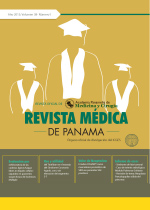Estudio Descriptivo De Pacientes Con Complicaciones Obstétricas Y Trombofilias Y Evaluación De Su Tratamiento, 2004-2012.
Autores/as
DOI:
https://doi.org/10.37980/im.journal.rmdp.2014156Resumen
Las complicaciones del embarazo debidas a alteración de la circulación útero-placentaria se han asociado a trombofilias en los últimos años. Sin embargo, con la excepción del síndrome antifosfolípido, la evidencia no es definitiva en demostrar esta asociación y la utilidad del tratamiento. Por ello realizamos el presente estudio para evaluar la realidad local, con el objetivo de determinar las características clínicas y de laboratorio de las pacientes con complicaciones obstétricas y sospecha de trombofilias y evaluar el resultado del tratamiento aplicado.
Se recogieron los datos clínicos y las pruebas de laboratorio de 713 pacientes desde julio de 2004 a septiembre de 2012. De estas, 524 pacientes tenían criterio clínico y de laboratorio de trombofilias (Grupo 1), 71 pacientes tenían criterio clínico, pero pruebas normales (Grupo 2) y 114 pacientes no completaban el criterio clínico, pero tenían por lo menos un test alterado (Grupo 3). Cuatro (4) pacientes no completaban el criterio clínico ni de laboratorio.
Ninguna característica clínica individualmente, tuvo una frecuencia estadísticamente significativa, al comparar el Grupo 1 versus el Grupo 2.
Al comparar el Grupo 1 versus el Grupo 3, las pruebas de laboratorio con diferencias en sus frecuencias estadísticamente significativas fueron el inhibidor lùpico (p=4x10-7)
y la resistencia a la proteína C activada (p=0.04). Estuvieron cerca de significancia estadística la hiperhomocisteinemia (p=0.07) y la mutación homocigota de la MTHFR (p=0.08).
Las frecuencias de niveles de vitamina B12 bajos (menos de 200 ρg/ml) fueron de 25.5% en el Grupo 1, 20.0% en el Grupo 2 y 30.0% en el Grupo 3. Las frecuencias de niveles de vitamina B12 normal baja (200-300 ρg/ml) fueron de 39.6% en el Grupo 1, 38.0% en el Grupo 2 y 34.3% en el Grupo 3. Ninguna de estas frecuencias tuvo diferencias estadísticamente significativas.
Al estratificar los niveles de vitamina B12, de acuerdo a la mutación de la MTHFR, el nivel promedio fue menor en el Grupo 1 en comparación con el Grupo 3, en el estado homocigoto mutado (273.2+/-112 vs 316.9+/-152 ρg/ml) y homocigoto normal (269.0+/-137.6 ρg/ml vs 332.5+/-236.7 ρg/ml).
De los 297 embarazos del Grupo 1 tratados con heparina de bajo peso molecular nacieron vivos 79.4%; y en los 14 embarazos tratados con aspirina a 80-100 mg por día, nacieron vivos 57.1%. Hubo 40 complicaciones siendo la prematuridad y la preeclapsia las más frecuentes.
Se concluye que ninguna característica clínica pudo distinguir a las pacientes que tendrían pruebas de laboratorio alteradas; el inhibidor lùpico y la resistencia a la proteína C activada son las pruebas con diferencias estadísticas en la evaluación de laboratorio y la hiperhomocisteinemia y la mutación homocigota para la MTHFR estuvieron cerca de la significancia estadística; en un número significativo de pacientes se encontró deficiencia de vitamina B12, lo cual puede ser una causa de pérdidas gestacionales recurrentes, y la respuesta al tratamiento está dentro de lo reportado en la literatura para el manejo de síndrome antifosfolípidos.
Descriptive study of patients with obstetric and Thrombophilias and evaluation of its treatment, complications 2004-2012.
Abstract
Complications of pregnancy due to alteration of the uterus-placental circulation have been associated with thrombophilias in recent years. However, with the exception of the antiphospholipid syndrome, the evidence is not definitive in demonstrating this association and the usefulness of treatment. Therefore we performed this study to assess the local reality, with the objective of determining the clinical features and laboratory of patients with obstetric complications and suspicion of thrombophilias and to evaluate the outcome of treatment.
We collected the clinical data and laboratory tests of 713 patients from July 2004 to September 2012. Of these, 524 patients had clinical and laboratory criteria of thrombophilias (Group 1), 71 patients had clinical characteristics, but normal tests (Group 2) and 114 patients not completed clinical characteristics, but had at least one altered test (Group 3). Four (4) patients had not the clinical/laboratory yardstick.
No clinical feature individually, had a statistically significant frequency, when comparing Group 1versus Group 2.
When Group 1versusGroup 3 were compared, laboratory tests with its statistically significant frequency differences were lupic inhibitor (p = 4 x 10-7) and resistance to activated protein C (p = 0.04).Other variables evaluated were anticardiolipin antibodies title, protein C, protein S, antithrombin and homocystein levels, mutation for Factor V Leiden, Factor II (G20210A), and mutation for metilen-tetra-hydro-folate-reductase (MTHFRAla667Val).
In Group 1, two hundred ninety seven (297) pregnancies were treated with low molecular weight heparin, and 79.4% were born alive; 14 pregnancies were treated with 80-100 mg of aspirin per day, and 57.1%were born alive. There were 40 complications, being the most frequent prematurity and preeclampsia.
It is concluded that no clinical feature could distinguish patients who would have altered laboratory tests; the lupic inhibitor and resistance to activated protein C are the tests with statistical differences in the evaluation of laboratory, and the response to treatment is similar to the reported in the literature for the management of antiphospholipid syndrome.
Key Word: Thrombophilia, antiphospholipid syndrome, lupus inhibitor.
Publicado
Número
Sección
Licencia
Derechos autoriales y de reproducibilidad. La Revista Médica de Panama es un ente académico, sin fines de lucro, que forma parte de la Academia Panameña de Medicina y Cirugía. Sus publicaciones son de tipo acceso gratuito de su contenido para uso individual y académico, sin restricción. Los derechos autoriales de cada artículo son retenidos por sus autores. Al Publicar en la Revista, el autor otorga Licencia permanente, exclusiva, e irrevocable a la Sociedad para la edición del manuscrito, y otorga a la empresa editorial, Infomedic International Licencia de uso de distribución, indexación y comercial exclusiva, permanente e irrevocable de su contenido y para la generación de productos y servicios derivados del mismo. En caso que el autor obtenga la licencia CC BY, el artículo y sus derivados son de libre acceso y distribución.






